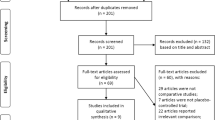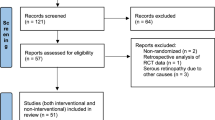Abstract
Purpose
This meta-analysis was conducted to investigate whether usage of corticosteroids was associated with an increased risk of central serous chorioretinopathy by summarizing all available evidence.
Methods
PubMed, EMBASE, Cochrane Library, and Web of Science databases were searched for all relevant studies published from inception to April 2019. Studies investigating the association between corticosteroids and the risk of central serous chorioretinopathy were included.
Results
Six case-control studies were finally included for the meta-analysis after study selection. The results of the analysis showed that there was a significantly higher risk of central serous chorioretinopathy among patients who once used corticosteroids (N = 707) compared with individuals without the usage of corticosteroids (N = 1927) (OR 4.050, 95% CI 2.270 to 7.220, I2 = 59%, P < 0.001). Results were the same for taking corticosteroids orally (OR 1.650, 95% CI 1.510 to 1.810, I2 = 47%, P < 0.001), through injection (OR 1.660, 95% CI 1.440 to 1.910, I2 = 0%, P < 0.001), and through nasal spray (OR 1.910, 95% CI 1.500 to 2.420, I2 = 17%, P < 0.001), but not for inhaled usage (OR 1.340, 95% CI 0.900 to 1.990, I2 = 0%, P = 0.160).
Conclusions
In conclusion, this meta-analysis demonstrated that patients with the usage of corticosteroids had an increased risk of central serous chorioretinopathy. Patients who were prescribed with corticosteroids need greater attention to their retina health. Also, all central serous chorioretinopathy (CSC) patients should avoid the use of corticosteroids as much as they possibly can.





Similar content being viewed by others
References
Haimovici R, Koh S, Gagnon DR, Lehrfeld T, Wellik S (2004) Risk factors for central serous chorioretinopathy: a case–control study. Ophthalmology 111(2):244–249. https://doi.org/10.1016/j.ophtha.2003.09.024
Wang M, Munch IC, Hasler PW, Prünte C, Larsen M (2008) Central serous chorioretinopathy. Acta Ophthalmol 86(2):126–145
Liegl R, Ulbig MW (2014) Central serous chorioretinopathy. Ophthalmologica Journal international d'ophtalmologie International journal of Ophthalmologica Zeitschrift fur Augenheilkunde 232(2):65–76. https://doi.org/10.1159/000360014
Gilbert CM, Owens SL, Smith PD, Fine SL (1984) Long-term follow-up of central serous chorioretinopathy. Br J Ophthalmol 68(11):815–820
Piccolino FC, De La Longrais RR, Manea M, Cicinelli S, Ravera G (2008) Risk factors for posterior cystoid retinal degeneration in central serous chorioretinopathy. Retina 28(8):1146–1150. https://doi.org/10.1097/IAE.0b013e318175421f
Kaya M, Kaya D, Idiman E (2017) Corticosteroid-associated atypical central serous chorioretinopathy in a patient with multiple sclerosis. Int J Ophthalmol 10(5):819–821. https://doi.org/10.18240/ijo.2017.05.27
Geoffroy M, Afriat M, Fauconier M, Eschard JP, Salmon JH (2018) Adverse effect of corticosteroid therapy: central serous chorioretinopathy. Joint Bone Spine 85(1):127–128. https://doi.org/10.1016/j.jbspin.2017.02.001
Rueda-Rueda T, Sanchez-Vicente JL, Llerena-Manzorro L, Medina-Tapia A, Gonzalez-Garcia L, Alfaro-Juarez A, Vital-Berral C, Lopez-Herrero F, Munoz-Morales A, Ortega LS, Herrador-Montiel A (2017) Bilateral exudative retinal detachment associated with central serous chorioretinopathy in a patient treated with corticosteroids. Arch Soc Esp Oftalmol 92(10):481–485. https://doi.org/10.1016/j.oftal.2017.01.002
Smuin DM, Seidenberg PH, Sirlin EA, Phillips SF, Silvis ML (2016) Rare adverse events associated with corticosteroid injections: a case series and literature review. Curr Sports Med Rep 15(3):171–176. https://doi.org/10.1249/JSR.0000000000000259
Ben Salem S, Sithom A, Ben Dhia I, Khelifi T, Askri H, Ayed A (2016) Central serous chorioretinopathy after nasal corticosteroids in the aviator. Tunis Med 94(12):893
Valls Pascual E, Martinez-Costa L, Santander F (2015) Central serous chorioretinopathy and systemic corticosteroids in rheumatic diseases: report of three cases. BMC Musculoskelet Disord 16:378. https://doi.org/10.1186/s12891-015-0843-4
Tittl MK, Spaide RF, Wong D, Pilotto E, Yannuzzi LA, Fisher YL, Freund B, Guyer DR, Slakter JS, Sorenson JA (1999) Systemic findings associated with central serous chorioretinopathy. Am J Ophthalmol 128(1):63–68
Carvalho-Recchia CA, Yannuzzi LA, Negrão S, Spaide RF, Freund KB, Rodriguez-Coleman H, Lenharo M, Iida T (2002) Corticosteroids and central serous chorioretinopathy. Ophthalmology 109(10):1834–1837. https://doi.org/10.1016/S0161-6420(02)01117-X
Van Staa T, Leufkens H, Abenhaim L, Zhang B, Cooper C (2000) Use of oral corticosteroids and risk of fractures. J Bone Miner Res 15(6):993–1000
Stang A (2010) Critical evaluation of the Newcastle-Ottawa scale for the assessment of the quality of nonrandomized studies in meta-analyses. Eur J Epidemiol 25(9):603–605
Higgins JP, Green S (2011) Cochrane handbook for systematic reviews of interventions 5.1. 0. The Cochrane Collaboration:33–49
Chang YS, Weng SF, Chang C, Wang JJ, Wang JY, Jan RL (2015) Associations between topical ophthalmic corticosteroids and central serous chorioretinopathy: a Taiwanese population-based study. Invest Ophthalmol Vis Sci 56(6):4083–4089. https://doi.org/10.1167/iovs.14-16360
Karadimas P, Bouzas EA (2004) Glucocorticoid use represents a risk factor for central serous chorioretinopathy: a prospective, case-control study. Graefes Arch Clin Exp Ophthalmol 242(9):800–802. https://doi.org/10.1007/s00417-004-0885-z
Mansuetta CC, Mason IJO, Swanner J, Feist RM, White MF Jr, Thomley ML, McGwin G Jr, Emond TL (2004) An association between central serous chorioretinopathy and gastroesophageal reflux disease. Am J Ophthalmol 137(6):1096–1100. https://doi.org/10.1016/j.ajo.2004.01.054
Tsai DC, Chen SJ, Huang CC, Chou P, Chung CM, Chan WL, Huang PH, Lin SJ, Chen JW, Chen TJ, Leu HB (2014) Risk of central serous chorioretinopathy in adults prescribed oral corticosteroids: a population-based study in Taiwan. Retina 34(9):1867–1874. https://doi.org/10.1097/iae.0000000000000159
Bouzas EA, Karadimas P, Pournaras CJ (2002) Central serous chorioretinopathy and glucocorticoids. Surv Ophthalmol 47(5):431–448
da Silva FT, Hirata CE, Sakata VM, Olivalves E, Preti R, Pimentel SLG, Gomes A, Takahashi WY, Costa RA, Yamamoto JH (2012) Indocyanine green angiography findings in patients with long-standing Vogt-Koyanagi-Harada disease: a cross-sectional study. BMC Ophthalmol 12. https://doi.org/10.1186/1471-2415-12-40
Guyer DR, Yannuzzi LA, Slakter JS, Sorenson JA, Ho A, Orlock D (1994) Digital indocyanine green videoangiography of central serous chorioretinopathy. Arch Ophthalmol 112(8):1057–1062
Bill A, Sperber G (1990) Control of retinal and choroidal blood flow. Eye 4(2):319
Gemenetzi M, De Salvo G, Lotery AJ (2010) Central serous chorioretinopathy: an update on pathogenesis and treatment. Eye (Lond) 24(12):1743–1756. https://doi.org/10.1038/eye.2010.130
Hadcock JR, Malbon CC (1988) Regulation of beta-adrenergic receptors by “permissive” hormones: glucocorticoids increase steady-state levels of receptor mRNA. Proc Natl Acad Sci 85(22):8415–8419
Sakaue M, Hoffman BB (1991) Glucocorticoids induce transcription and expression of the alpha 1B adrenergic receptor gene in DTT1 MF-2 smooth muscle cells. J Clin Invest 88(2):385–389
Makara GB, Haller J (2001) Non-genomic effects of glucocorticoids in the neural system: evidence, mechanisms and implications. Prog Neurobiol 65(4):367–390
Mann R, Riva C, Stone R, Barnes G, Cranstoun S (1995) Nitric oxide and choroidal blood flow regulation. Invest Ophthalmol Vis Sci 36(5):925–930
Prünte C, Flammer J (1996) Choroidal capillary and venous congestion in central serous chorioretinopathy. Am J Ophthalmol 121(1):26–34
Araque K, McGlotten RN, Nieman LK (2017) Cushing's syndrome and the development of central serous chorioretinopathy. Experience at the national institutes of health. Endocr Rev 38(3)
Bouzas EA, Scott MH, Mastorakos G, Chrousos GP, Kaiser-Kupfer MI (1993) Central serous chorioretinopathy in endogenous hypercortisolism. Arch Ophthalmol 111(9):1229–1233
Chalisgaonkar C, Chouhan S, Lakhtakia S, Choudhary P, Dwivedi PC, Rathore MK (2010) Central serous chorioretinopathy and endogenous cortisol-is there an association. Indian J Ophthalmol 58(5):449–450. https://doi.org/10.4103/0301-4738.67055
Garg SP, Dada T, Talwar D, Biswas NR (1997) Endogenous cortisol profile in patients with central serous chorioretinopathy. Br J Ophthalmol 81(11):962–964
Esfahani MR, Torabi HR, Harandi ZA, Zarei M (2010) Ketoconazole in the treatment of central serous chorioretinopathy. Iran J Ophthalmol 22(4):59–65
Golshahi A, Klingmueller D, Holz FG, Eter N (2010) Ketoconazole in the treatment of central serous chorioretinopathy: a pilot study. Acta Ophthalmol 88(5):576–581. https://doi.org/10.1111/j.1755-3768.2008.01467.x
Meyerle CB, Freund KB, Bhatnagar P, Shah V, Yannuzzi LA (2007) Ketoconazole in the treatment of chronic idiopathic central serous chorioretinopathy. Retina 27(7):943–946
Fardin B, Weissgold DJ (2002) Central serous chorioretinopathy after inhaled steroid use for post-mycoplasmal bronchospasm [4]. Br J Ophthalmol 86(9):1065–1066. https://doi.org/10.1136/bjo.86.9.1065
Haimovici R, Gragoudas ES, Duker JS, Sjaarda RN, Eliott D (1997) Central serous chorioretinopathy associated with inhaled or intranasal corticosteroids. Ophthalmology 104(10):1653–1660
Funding
This study is funded by the National Natural Science Foundation of China (no. 81271019) and the Sichuan Provincial Science, Technology Support Project (no. 2019YJ0129), and National Clinical Research Center for Geriatrics, West China Hospital, Sichuan University (no. Z2018B22).
Author information
Authors and Affiliations
Corresponding author
Ethics declarations
Conflict of interest
The authors declare that they have no conflict of interest.
Ethical approval
This article does not contain any studies with human participants or animals performed by any of the authors.
Additional information
Publisher’s note
Springer Nature remains neutral with regard to jurisdictional claims in published maps and institutional affiliations.
Rights and permissions
About this article
Cite this article
Ge, G., Zhang, Y., Zhang, Y. et al. Corticosteroids usage and central serous chorioretinopathy: a meta-analysis. Graefes Arch Clin Exp Ophthalmol 258, 71–77 (2020). https://doi.org/10.1007/s00417-019-04486-w
Received:
Revised:
Accepted:
Published:
Issue Date:
DOI: https://doi.org/10.1007/s00417-019-04486-w




